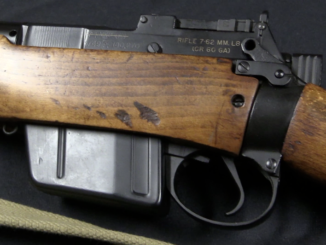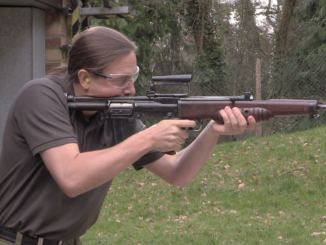In my recent video on the Whitworth rifle, I made a rather embarrassing mistake, interpreting “figure of merit” accuracy measurements as complete group sizes. This was incorrect, and caused me to seriously overestimate the accuracy of the Whitworth. It was indeed a outstandingly accurate rifle, but not to the levels I originally stated. In actual fact, the Whitworth was capable of about 3 MOA at 500 yards; not the sub-1 MOA I originally stated.
The numbers recorded at the 1857 test of Enfield vs Whitworth were figure of merit, aka mean radial dispersion. This is the average distance from the center of a group (20-shot group, per British standards) to the point of impact. While much more involved to calculate, this type of measurement provides a more useful measure of accuracy than simple overall group size.
Thanks to John Simpson, David Minshall, and Rob (BritishMuzzleLoaders) for spotting and correcting this mistake!
You can see David’s article on this issue here.
Rob has a video on Figure of Merit, which is here.
And John’s book on sniping can be found here.




I thought that figure was a bit fishy. 3 MOA at 500 yards is not shabby. I don’t think that I could do that with iron sights.
You can do better with the Swiss K31 without optics. But more importantly, 3 MOA at 500 yards is still good enough to pot a general who doesn’t have common sense…
Gettysburg film, bang. Union chap, shot by a C.S.A sniper, with a weapon that looks like this. Worked clearly…
I admire your candour.
“Accuracy” back then meant something different than what we define as accuracy today.
For instance, in Arms and Equipment of the Civil War by Jack Coggins (1965), the Model 1857 “Napoleon” 12-pounder smoothbore gun-howitzer is quoted as having a horizontal deviation (right or left of point of aim) of 3 feet at 600 yards, increasing to 12 feet at 1200 yards. (Any arty experts out there who can calculate that in mils?)
That works out to 1 yard at 600 and 4 yards at 1200. That seems fairly accurate for a non-rifled weapon. Not to mention close enough to be uncomfortable when an explosive shell or “spherical case” arrives just as the time fuse burns down to BOOM.
If a smoothbore could do that well, how good were the rifled field guns?
cheers
eon
“Any arty experts out there who can calculate that in mils?”
DISCLAIMER: FOLLOWING ARE FOR COM-BLOC STYLE MILS, DO NOT ASSUME IT HOLDS TRUE FOR SWEDISH MILS OR FRENCH MILS
“12 feet at 1200 yards”
Processing… 3,6576 m at 1097,28 m
This is easy trigonometry, right-angled triangle with one 1097,28 m edge one 3,6576 m edge and we need angle near longer edge, this mean that we need to use arctan function for value 3,6576/1097,28 ≈ 0,0033333333333333335. Arctan(0,0033333333333333335) ≈ 0,003333320987736625 radians, which give ≈ 3.1830870726614573 mils
(COM-BLOC STYLE) mils are explained in Russian here:
http://wio.ru/galgrnd/artill/art38/v084.htm
shortly speaking for COM-BLOC STYLE mils following hold true:
6000 mils = 360°
Рис. 177. shows sight through Soviet binoculars, it is scaled so between lines are 5 mils and between bigger lines are 10 mils
Рис. 180. shows value of usage of fingers for purpose of angle gathering, with extended arm, pinky finger give 20 mils, thumb give 40 mils all other 30 mills.
Рис. 181. shows value for pencil (12 mils) and box of matches
I’m glad you think that’s easy.
😉
cheers
eon
Well, it is quite basic trigonometry. You just need to know the definition of mil you want to use. You don’t have to use Arctan either, but it makes the conversion slightly easier.
“If a smoothbore could do that well, how good were the rifled field guns?”
Accuracy of modern artillery can is achieved not solely from precision rifling of liners, but also usage of advanced external equipment, firstly distance from target is measured much more precisely than with 1860s technology. Direction-speed of wind, air humidity, air temperature e.t.c. can be measured at given as input. Some artillery systems feature RADAR for measuring muzzle velocity (as it vary depending of batch of ammunition, weapon wear and others) which mean that muzzle velocity is precisely known during 2nd and later shots.
is: “(…)at given as input(…)”
should be: “(…)at given as input for director(…)”
In February 1944, one of the Iowa class battleships, I think the USS New jersey, took shots at a Japanese cruiser fleeing the air attack. From memory, the US battleship was cooking along at close to top speed, probably 31/32 knots, and the Japanese cruiser was probably a little faster. The very first salvo, at 38,000 yards, straddled the Japanese cruiser. The US battleship probably used radar for range and training, but everything else was analog fire-control computer.
The longest range hit by a battleship was 32,000 yards or so, by a British battleship I think.
All figures from memory. YMMV.
“The longest range hit by a battleship was 32,000 yards or so, by a British battleship I think.”
Monitor HMS General Wolfe according to https://en.wikipedia.org/wiki/HMS_General_Wolfe_(1915)
with an 18-inch (457 mm) gun(…)made the longest-range firing in the history of the Royal Navy – 36,000-yard (20 mi) – on a target at Snaeskerke, Belgium
18-inch gun was developed for large light cruiser (do not ask me why they have such class of ships) HMS Furious
FYI: There is a link to download an excel spreadsheet for calculating Figure of Merit here: https://www.tapatalk.com/groups/britishmilitariaforums/victorian-accuracy-measuring-figure-of-merit-calcu-t18600.html
You enter the X/Y locations of up to 20 rounds and it plots them on a graph and give you the various numbers including group size.
A mil (6400 mils to the circle as used in the USA, Germany and later NATO) is exactly 3.375 MOA.
The Russian/Soviet mil (6000) is 3.6 MOA.
The Swedish stryck (6300) is about 3.43 MOA.
According to the late Frank E. Grubbs, the U.S. definition of Figure of Merit is the sum of horizontal and vertical group size divided by 2.
Actually the US FOM was adopted in 1923, according the Julian Hatcher in Hatcher’s Notebook
https://archive.org/stream/Hatchers_Notebook#page/n431/mode/2up/search/merit
Sweden transitioned to NATO mil in 2007. Finland still uses the Russian mil. It is also used by some of the FSU countries which are not part of NATO.
Probably that wine, what you like! Ya mad boozer.
“Accuracy” in a military context means scaring the other side bad enough they decide to go home.
Two rules of artillery according to the USMC;
1. The “moral high ground” is the best place to site the artillery.
2. Only bring artillery if you intended to kill everybody.
Ian Hogg, Master Gunner RA, once observed that “In the Artillery, we don’t ‘rally ’round the colours’- our rally point is the nearest gun that will still fire.”
Or in other words, the “Redlegs” will always be found around the nearest piece of ordnance that they can still kill you with.
cheers
eon
In other words, don’t stop shooting until the other team is all dead.
On Ian’s original film about the Confederate Whitworth I posted from an external source that:
‘The report also compares the 12 inch grouping of the Whitworth at 1800 years to the 96 inch grouping at 1100 yards of the Enfield!’
I find that kind of comparison much easier to take in than Figure of Merit or MOA. The link for the source of the above is below:
http://www.guns.com/2013/09/09/whitworth-rifle-fit-queens-confederates-video/
With standard normal distribution, figure of merit aka AMR (average miss radius) for a 20 shot group is approximately 1.222. Average 5-shot group size for the same distribution is 3.066. So the ratio is slightly lower, about 2.51 rather than 3.